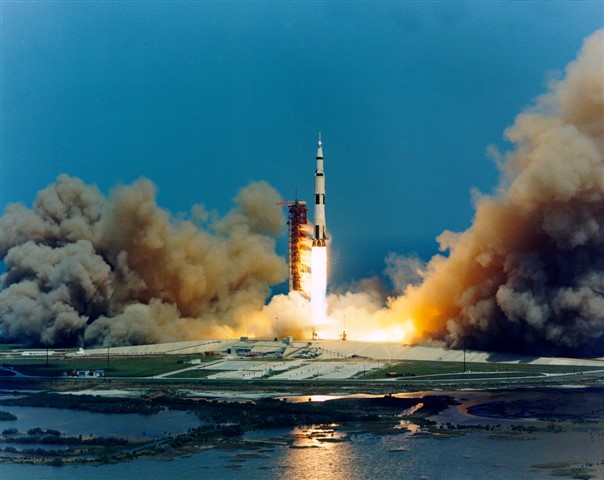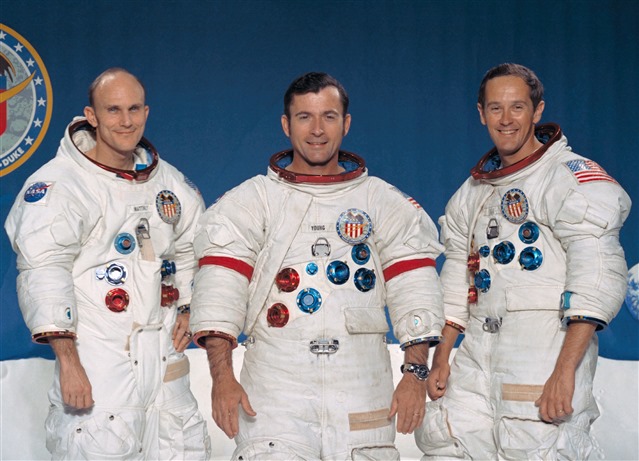On this day in (engineering) history…
There have been people occupying this spot, roughly halfway up Florida’s east coast, for 12,000 years. When Europeans arrived, the ‘cape of currents’ became notorious for shipwrecks. Its modern name was given by Spanish explorer Francisco Gordillo in 1521, first appearing on the map in 1564. Cabo Cañaveral (‘reed bed’ or ‘sugar cane plantation’), is the third oldest European place name in the USA.
Today, April 16, 1972, at 12:54pm EST, Apollo 16 blasts off from Cape Canaveral.

Apollo 16 blasts off from Launch Complex 39 at Kennedy Space Center, Florida. Source: Wikimedia Commons
This latest mission, would be the fifth to touch down on the Moon itself, (notoriously, Apollo 13 never made it to the surface but did return to Earth safely), the tenth crewed mission in the Apollo programme and the penultimate voyage to the lunar body.
It wasn’t straightforward.
Between Earth and the Moon, a signal warned of guidance system gimbal lock, this was corrected by reprograming the onboard computer to ignore the input. When the module was in lunar orbit - after the Lunar Module (Orion) undocked from the Command Service Module (Casper) – a backup circuit caused Casper to yaw unexpectedly. The landing was delayed while engineers worked out that the oscillations would not affect Casper’s steering.

The prime crew of the Apollo 16 lunar landing mission. From left to right: Thomas K. Mattingly II, Command Module pilot; John W. Young, Commander; and Charles M. Duke Jr., Lunar Module pilot. Source: Wikimedia Commons
The objective for the crew (Commander John Young, Command Module Pilot Thomas “Ken” Mattingly, and Lunar Module Pilot Charles Duke) was to inspect and survey the surface features of an area called the Descartes region. This is a hilly, highland section of the Moon’s south-east quadrant. There would experiments. A lot of experiments. Surface experiments, in-flight experiments, experiments which required zero gravity.
At 9:24pm EST (6 hours late), Young and Duke planted Orion between the North Ray Crater and South Ray Crater, a little under 300 metres from the original target in the Descartes Highlands. The area had been certified ‘safe’ following a photographic survey by Apollo 14.
Preparing the ground
The rugged terrain is adjacent to two especially interesting volcanic constructions, the Cayley formation on the Cayley Plains and the Descartes formation on the Kant Plateau. Cayley is an undulating landscape, while Descartes is rougher, hillier. Samples showed these were not volcanic in nature, but stemmed from debris caused by impact events which created larger lunar basins. It turned out there was next to no volcanic material to be found at the site.

John W. Young on the Moon during Apollo 16 mission jumping about 42 Centimetres high. Charles M. Duke Jr. took this picture. The LM Orion is on the left. April 21, 1972. Source: Wikimedia Commons
The first task was to set up the Lunar Rover, a vehicle that would allow Young and Duke to visit and remove samples from sites kilometres away from the landing site. They also set up a suite of nuclear-powered experiments called the Apollo Lunar Surface Experiments Package (ALSEP). These consisted of the Passive Seismic Experiment (PSE), the Active Seismic Experiment (ASE), the Lunar Heat Flow Experiment (LHFE) and the Lunar Surface Magnetometer (LSM). The nuclear thermoelectric generator would ensure the experiments could run after the astronauts had departed.
A drill designed for Apollo 15 to make holes in the lunar surface to set up the Heat Flow Experiment, had been modified to make the task easier. Or would have done if Young had not tripped on and broken an electrical cable for the drill.
How long…
Casper above the Moon Source: Wikimedia Commons
In all, Charles Duke and John Young spent 71 hours on the surface of the moon, with three extra vehicular activities (EVAs) totalling 20 hours and 17 minutes spent outside of Orion. In that time, they drove 4.6km from the main landing site and collected 96kg of rock samples. The delay in landing, caused by Casper’s engine problems meant the third EVA had to be cut short, to five hours and the mission would be ended a day early.
While this was going on, Ken Mattingly was piloting Casper. His task was to observe the Moon’s surface with binoculars and carrying out experiments similar to those undertaken on the surface. Apollo 16 circled the Moon 64 times during its slightly over five days in lunar orbit.
Duke, Mattingly and Young returned to Earth, safely, on April 27, 1972, splashing down in the Pacific, 11 days, and two hours after blasting off.
There have been numerous Moon missions, and not only from the US, since Apollo 17 left the satellite later in 1972. But no human has returned. NASA’s Artemis program would have landed four crew on the lunar surface in 2024, before it the agency announced delays over safety concerns.
----------------------------------------------------------------
What should be the priorities in any future human voyage to the moon?
How could a moonbase ever be made safe and practical?
---------------------------------------------------
 By Stephen Phillips - IET Content Producer, with passions for history, engineering, tech and the sciences.
By Stephen Phillips - IET Content Producer, with passions for history, engineering, tech and the sciences.